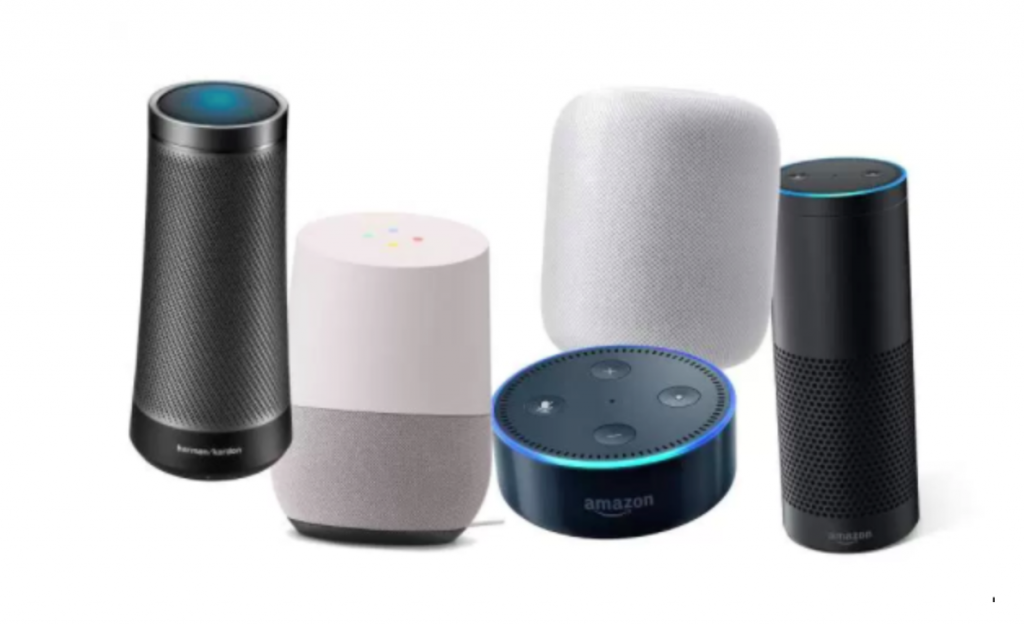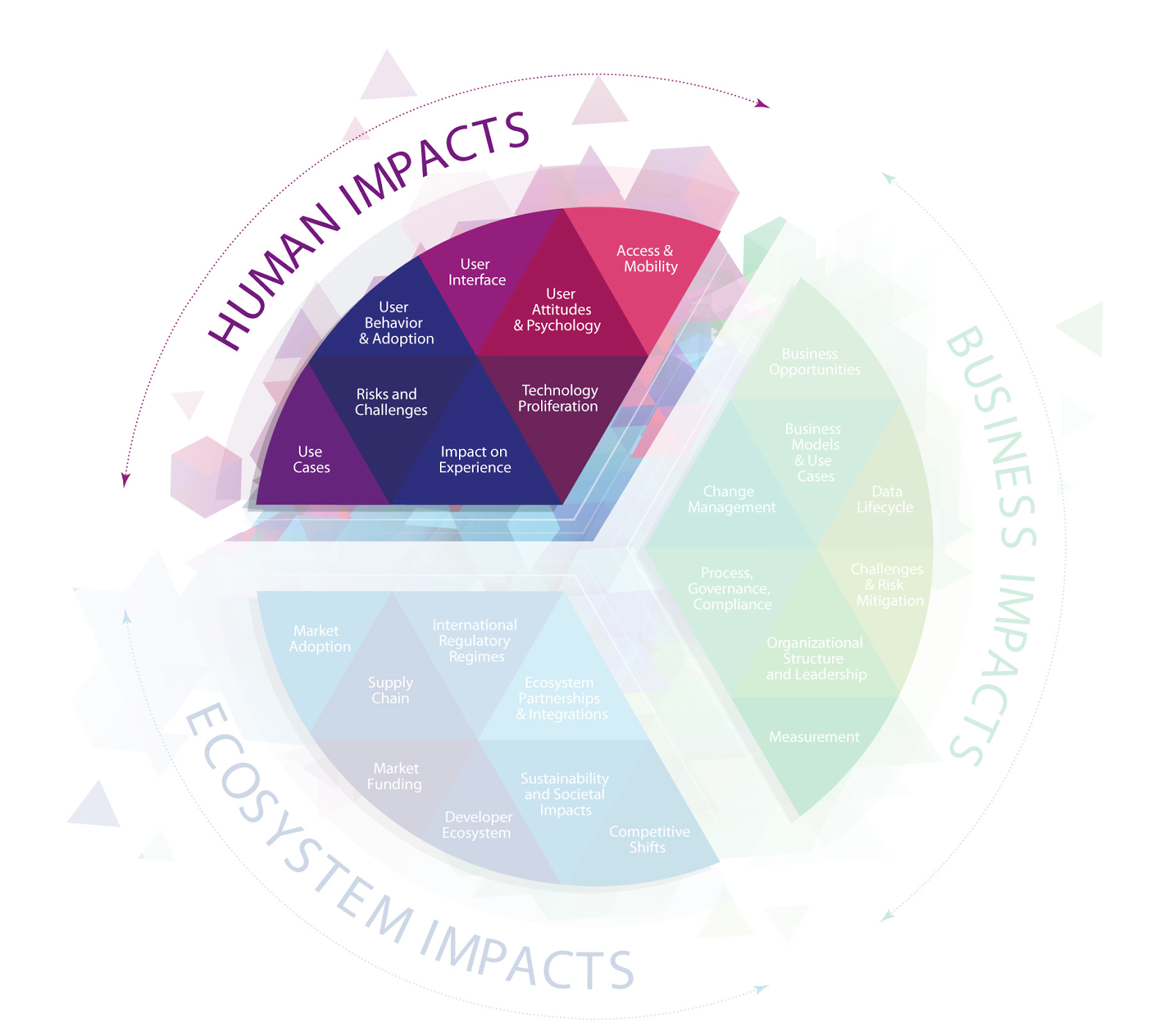
By Jeremiah Owyang, Jaimy Szymanski, Jessica Groopman, and Rebecca Lieb of Kaleido Insights.
We put them in our homes. We speak to them, listen to them, buy things from them. Much ado about smart speakers, but what are the implications for consumers and end users?
Kaleido Insights’ methodology for analyzing emerging technology assesses the impacts on humans, on businesses, and on the ecosystem. As part of our ongoing coverage, we’ll be covering a series of topics using our methodology to help business leaders first understand, and then see beyond the bright and shiny and cut right to what matters.
In each post, all Kaleido Insights analysts conduct a joint analysis session around one topic (i.e. technology, event, announcement, etc.) We begin with analyzing the human impacts of smart speakers.
Topic: Smart Speakers
Examples: Amazon Echo, Google Home, Sonos One, Apple Homepod, among many others
Impact Analysis: Humans (consumers and end users)

User Behavior & Adoption: While smart home adoption, measured by numerous devices, hovered around 10% market adoption for years, smart speakers have injected new life into this space. Adoption of smart speakers grew from 5% in Q4 2015 to 12% in Q4 2016 in US markets alone – a 130% CAGR. With the dominant Amazon having sold some 15.3 million Echos, Dots, and Taps in the last 12 months, according to Parks & Associates. The success of these devices has also made its way into cars, healthcare, and even industrial environments, and voice-enabled virtual assistants are now being integrated in a range of IoT platform solutions.
With adjacent advancements in natural language understanding, the technology leaders powering these devices are also expanding to Germany, France, Spain, and beyond. Interestingly, the smart speaker market in the West mirrors the parallel growth market in the East – social robots – also powered by voice-enabled virtual assistants but more anthropomorphic.

Today’s voice-enabled virtual agents for smart home adoption take different form factors in North America and Western Europe compared to popular devices in Asian markets
User Interface: Voice-enablement and hands-free user interface reduce barriers to entry for all. Simply put, it’s easier and it’s human. We are innately wired to learn and produce language with relatively little effort. Still, while voice is a significant improvement in interface in certain settings – kitchen, driving, holding children – it is not appropriate in all settings or when there is overwhelming background noise.
Impact on Experience: Ultimately reducing the friction of clicking, typing, and tapping with simply speaking introduces new convenience and efficiency. While smart speakers immediately reduce the friction of using technology in the home, they also offer brands new opportunities to improve broader customer experiences. For example, Domino’s Pizza allows enables customers to order a pizza from “anyware” – any hardware, that is – from an Apple Watch to a smart TV to the Google Home.
Both Amazon and Google recently announced, new ‘multi-step‘ actions, wherein devices execute multiple tasks with a single prompt, are just the latest updates designed to reduce friction. Simply saying “good morning” to instigate a news briefing, automatically brew coffee, and adjust the lighting for instance, is just another incremental advancement in leveraging voice interface to improve the smart home experience. Brands, manufacturers, and service providers are all flocking towards these devices
User Psychology: The emergence of smart speakers hasn’t just brought voice-interaction into the mainstream, it’s offered a glimpse into the power of anthropomorphizing devices. Never mind that smart speakers look like speakers, consumers expect them to seamlessly interact, and increasingly for agents to “remember” relevant information such as past search queries, feature preferences, and other context, just as a human would.
Pioneered by the likes of Siri, Google Assistant, and Alexa, consumers expectations for voice-enabled virtual agents are quickly spanning others devices too. Smart speaker owners often report how they expect other devices to have the same functionality – “why can’t I just tell my fan to turn off?”
Meanwhile, unlike in human interactions, virtual assistants are deaf to manners and non-responsive to social faux pas. When assistants fail, users are annoyed, often admitting to yelling or scolding them. Parents lament the fact that their kids can be as mean as they want, and virtual agents will remain subservient and friendly. Implications of these technologies on developmental and adult psychology remain woefully unclear.
Use Cases: Another driver of adoption of smart speakers is that they are inherently ‘horizontal’ in that they support a wide range of use cases. From listening to music, to turning on the lights, to ordering an Uber or virtually any other product, the use cases for these devices look more like a smartphone than any other consumer IoT or smart home device. Similar to a smartphone, wherein making phone calls is a tiny fraction of its capability, a smart speaker is something of a category misnomer; playing music is also just the tip of the iceberg. Instead, these devices are better understood as voice-enabled vehicles for cloud services and mobile apps.
Perhaps one of the most critical impacts of smart speakers in consumer markets is they set a precedent for product appreciating over time, compared to past models in which products only depreciated after purchase. Both Amazon and Google offer open up development to the broader ecosystem meaning manufacturers, brands, and even individual developers can create new apps, new features, and integrations all the time. This open and expanding ecosystem doesn’t just create a better out-of-the-box experience, it also extends the range of potential use cases, users, and value over time.
Access & Mobility: Some technologies help enable or mobilize new segments of people. While this is great for adoption and brand marketers, in certain cases it can also enhance people’s lives. Consider, for instance, how smart speakers are enabling elderly folks to listen to audiobooks, connect with family members, and use home care apps; and disabled folks to enjoy internet services, play games, live more independently, or even offers kids story time enhancement.
Risks & Challenges: Despite the growing success of smart speakers in the home, the technology carries a host of risks and challenges for brands and consumers alike. Zeroing in on impacts to humans, Kaleido analysts identify risks associated with user privacy, data protection associated with cloud-based processing of highly sensitive data, as well as user experience.
A recent murder case cast a spotlight on Amazon as questions of privacy, consent, evidence, caused the company to hand over sensitive Echo data to Arkansas officials. In addition, smart speakers in the US have tangled with the Child Online Privacy Protection act (COPPA) – and soon with the EU’s Global Data Protection Regulation (GDPR) – , prompting Amazon to recently unveil parental consent and control features as well as child-specific skills. And Google’s latest product must have a feature disabled due to a privacy mishap. Even without the sensitive content, most smart speakers today are not designed for multi-user personalization, even if they are used by multiple users.
Technology Proliferation: Although smart speakers have improved the user experience in the smart home, challenges remain on the technology side. For one, no one wants to have 17 different apps for 17 different devices; we don’t want to be system administrators for our homes. And while smart speakers have shifted the form factor of a ‘home automation’ hub (from an app or gateway to a speaker) the administration of these devices, their apps, and data remains a cumbersome user experience even for the technologically proficient.
Then there are additional challenges around interoperability. Consumers don’t want to be boxed in to using single brands or manufacturers, and especially in the home. Although both Amazon and Google offer an impressive (and growing) array of service and product integrations through their Skills and Actions SDKs respectively, they draw a line when it comes to each other. Fiercely competitive Google won’t integrate with Amazon or Apple, and vice versa.
Smart speakers mark an exciting technological shift, most notably in accelerating voice as a mainstream human-machine interface. Over time though, Kaleido analysts expect form factor will be de-emphasized and eventually disappear, as the machine and deep learning behind these virtual agents will:
- Learn: They become hyper-personalized to individual users, as we train these systems to become our friends, mates, and more.
- Predict: What customers want based on multi-modal historical and real-time data sets Transcend any single form factor, instead “follow” users wherever they go (home, office, car, retail, medical, etc.)
- Infuse: almost any physical space with speaking, thinking, predictive services… and sentience? The digital interface is not needed where sound travels.
This is just one of the myriad technologies shifting how businesses interact with consumers and their ecosystems. And these are just a few of the many impacts on consumers today. Kaleido analysts are tracking these and other technologies closely to help you find clarity amidst the chaos. Interested in discussing the impacts of smart speakers? Don’t hesitate to reach out.